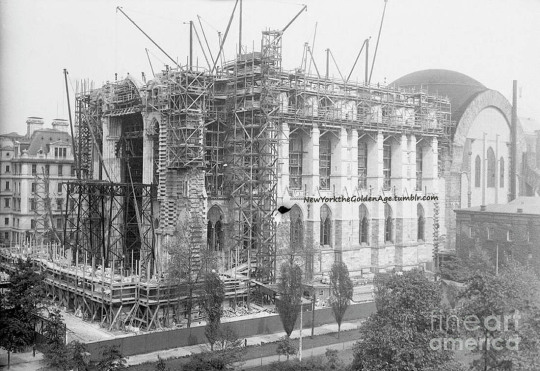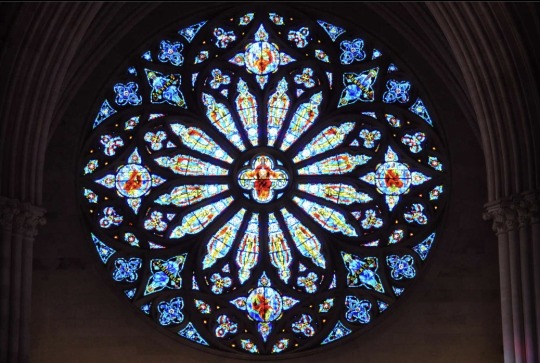#st. john the divine
Text
George Nakashima






George Nakashima’s Woodworker’s Retreat featured at the University of Pennsylvania

The Nakashima Woodworker’s Retreat “Arts Building” was given to the Nakashima Foundation for Peace in 2001 by George’s widow Marion so that the Foundation would have a permanent home. It features a soaring plywood hyperbolic paraboloid roof cantilevered from stone buttresses over two glass walls, built around a small pond and facing a series of small rooms known as the “Cloister,” harking back to the monastic tradition which so inspired Nakashima. It is used for concerts and events for peace, and houses prototype furniture and archival material, some of which will be turned over to the Michener Museum for research, reference and preservation.
National Historic Landmark nomination for the Nakashima complex
George Nakashima’s Vision
“A while back there appeared a great bole of a tree, a Walnut. It was about five feet in diameter (1.5M) at the small end, about seven (2.1M) at the flare, and twelve (3.6M) long, with extraordinary characteristics. In a small but firm voice the bole asked to be realized; two adjoining slabs opened to make an extraordinary table, roughly twelve feet (3.6M) long by the same dimension wide, weighing almost 1 ton. Gradually a few people became interested in the project and suggested we make six Altars—one for each Continent. It will be a symbol, a token of man’s aspirations for a creative and beautiful peace, free of political overtones; an expression of love for his fellow man. We have become so basically disoriented with our blind faith in science and technology without spirituality, it brought us to our pit of madness.
A symbol is needed—something tangible, like the toe of St. Peter’s statue in the Vatican. This symbol might be the object of a transcontinental or trans-world Peace March. At the end of this pilgrimage, a celebration: A rose or lotus placed on it; songs sung, each in his own tongue; Zen chants so strong; possibly the Day of Existence, a chant to music—spheric in line, spiritual and sad—composed by my ‘brother’ Ivan Wyschnegradsky; Sadhu friends from South India congregating; and monks and others from all over the world who are interested in a higher and deeper consciousness. There is little chance that peace can be achieved politically. There is, at best, a balance of terror; a balance of egos; a balance of demands. Enthusiastic contagion would be useful, as peace the world over is uppermost in our consciousness. It must be a joyous peace, not a fear or absence of war. It is a question of surrender. A surrender to the Divine Consciousness to end in a most beautiful aura of love.”
George Nakashima
October 1, 1984
A Black Walnut Dream: George Nakashima's "Altars of Peace"

The name of George Nakashima is as famous for its contributions to design philosophy as it is for its artistry. As a woodworker, furniture maker, designer, and architect, Nakashima has enough titles to cement his place as the father of the American Craft Movement. But around the world, a separate legacy follows the renowned Japanese-American craftsman: his interest in world peace and humanitarianism through design. Here we explore a project that was particularly close to his heart.



George Nakashima admiring the finished Altar in the Arts Building on the Nakashima compound before sending it to the Cathedral of St. John the Divine, in New York.
#George Nakashima#nakashima#artists#woodworking#carpentry#altars of peace#photography#philosophy#new york#St. John the Divine#University of Pennsylvania
200 notes
·
View notes
Text


The Cathedral of St. John the Divine, New York City
The Cathedral of St. John the Divine, New York (Episcopal). The largest Gothic Cathedral in the World, length 601 feet, breadth at Transepts 320 feet, height of Central Tower 455 feet, Western Towers 265 feet. Building commenced St. John's Day, 1892.
#postcard#post card#nyc#new york city#st. john the divine#cathedral#gothic#gothic architecture#prewar#vintage
4 notes
·
View notes
Text

Construction of the Cathedral of St. John the Divine (Episcopal) in Morningside Heights, near Columbia University, August 1927. Although the work had been started in 1892, the building was still far from finished—and still is, nearly a century later.
Photo: Bettmann Archive/Getty Images/Fine Art America
#vintage New York#1920s#Episcopal cathedral#Cathedral of St. John the Divine#cathedral#construction#Morningside Heights#vintage NYC
77 notes
·
View notes
Text

“An angel fell from Heaven without any other passion except pride, and so we may ask whether it is possible to ascend to Heaven by humility alone, without any other of the virtues.”
+ St. John of the Ladder
#eastern orthodox#eastern orthodoxy#orthodox christianity#orthodoxy#greek orthodox#christianity#orthodox#orthodox church#serbian orthodox#church#St. John Climacus#The Ladder of Divine Ascent
34 notes
·
View notes
Text
SAINT OF THE DAY (October 5)

On October 5, the church celebrates the Memorial of St. Mary Faustina Kowalska, virgin.
St. Faustina was born Helena Kowalska on 25 August 1905 to a poor but devout Polish family in 1905.
At the age of 20, with very little education, and having been rejected from several other convents because of her poverty and lack of education, Helen entered the Congregation of the Sisters of Our Lady of Mercy.
There, she took the name Sr. Faustina and spent time in convents in both Poland and Lithuania.
Throughout her life, Jesus appeared to Sr. Faustina.
He asked her to become an apostle and secretary of his mercy by writing down his messages of Divine Mercy for the world in her diary.
Jesus also asked Sr. Faustina to have an image painted of his Divine Mercy, with red and white rays issuing from his heart, and to spread devotion to the Divine Mercy novena.
Even before her death on 5 October 1938, devotion to Divine Mercy began to spread throughout Poland.
This little nun and Jesus’ message of Divine Mercy impacted Karol Wojtyla greatly, which became obvious to the world when he was elected pope.
“It is truly marvelous how her devotion to the merciful Jesus is spreading in our contemporary world and gaining so many human hearts!
This is doubtlessly a sign of the times — a sign of our twentieth century.
The balance of this century, which is now ending, in addition to the advances which have often surpassed those of preceding eras, presents a deep restlessness and fear of the future.
Where, if not in the Divine Mercy, can the world find refuge and the light of hope? Believers understand that perfectly,” Pope St. John Paul II wrote.
On 30 April 2000, Pope John Paul II canonized St. Faustina in what he was widely reported as saying was “the happiest day of my life.”
“Today, my joy is truly great in presenting the life and witness of Sr. Faustina Kowalska to the whole Church as a gift of God for our time.
By divine Providence, the life of this humble daughter of Poland was completely linked with the history of the 20th century, the century we have just left behind.
In fact, it was between the First and Second World Wars that Christ entrusted his message of mercy to her.
Those who remember, who were witnesses and participants in the events of those years and the horrible sufferings they caused for millions of people, know well how necessary was the message of mercy,” the Pope said in his homily that day.
It was also on this day, the Sunday after Easter, that Pope John Paul II instituted the Feast of Divine Mercy, which Jesus had asked for in his messages to Sr. Faustina.
#Saint of the Day#St. Mary Faustina Kowalska#Helena Kowalska#Divine Mercy#Pope St. John Paul II#Feast of Divine Mercy
9 notes
·
View notes
Text

Literary NYC: A Literary Landmark Honoring Madeleine L’Engle!
2 notes
·
View notes
Text

A man should know that a devil's sickness is on him if he is seized by the urge in conversation to assert his opinion, however correct it may be. If he behaves this way while talking to his equals, then a rebuke from his seniors may heal him. But if he carries on in this way with those who are greater and wiser than he, his sickness cannot be cured by human means. He who is not submissive in his talk will certainly not be so in what he does. To be unfaithful in the small things is to be unfaithful in the great, and this is very hard to bring under control.
St. John Climacus
Ladder of Divine Ascent
On Obedience
15 notes
·
View notes
Text

made it back to the procession of the ghouls at st john the divine for the first time in several years, and I'm still thinking about how great these ghouls were. I've got some video over on tiktok for fellow ghoul-enjoyers.
7 notes
·
View notes
Text
25th April
St Mark’s Day

Herbert Beerbohm Tree (1852-1917) as King John in King John by William Shakespeare. Source: Medium website.
Today is St Mark’s Day, the Evangelist of the Gospels. It is also the day in the thirteenth century when an infuriated King John, who found his royal regalia spattered by mud during a visit to Alnwick in Northumberland, inflicted a humiliating punishment on the local townsfolk for their poor upkeep of the roads. Every April 25th, the people of Alnwick were obliged to ride the roads and boundaries of the parish, taking the then difficult, and very wet, route through Freeman’s Well, a nearby pond. The boundary riders, forced to wear all white, the better to show up the dirt and mud they accumulated on their pointless ride, wielding swords and with night caps on their heads, had to dismount at the well, wade across it, then remount and carry on with their boundary ride. Extraordinarily, this masochistic tradition continued long after bad King John (who doubtless the whole business hilarious) had died.
In another tradition of St Mark’s Day divination, if you cast down a handful of ash, chaff or beans before your hearth after the last stroke of midnight, a mysterious footprint will appear in the scattering, belonging to your future love. Quite how you then identify your lover is left to you.
0 notes
Text
Celebrating Divine Mercy: A Feast of Forgiveness and Hope
The Feast of Divine Mercy, celebrated on the second Sunday of Easter, is a powerful testament to God’s boundless love and mercy for all humanity. Rooted in the revelations of St. Faustina Kowalska, this feast is a call to experience God’s forgiveness, embrace compassion, and live a life filled with mercy.
Continue reading Celebrating Divine Mercy: A Feast of Forgiveness and Hope

View On WordPress
0 notes
Text
Practice English
share.libbyapp.com/title/83266
View On WordPress
#bookporn#Cosmic Thing#English as a Second Language#ESL#fiction#giallo#intrigue#John Le Carre#la source#Libby#Los Misterios#Noir#NYPL#practice English#Q#Quelle#St John The Divine Baptist#vocabulary bldg
0 notes
Text



youtube
#EpiscopalChurch#AnglicanChurch#Cathedrals#NYC#Brooklyn#Queens#Bronx#StatenIsland#LongIsland#WashingtonDC#USA
1 note
·
View note
Text
Embrace the Longest Night: Winter Solstice 2023
As the days grow shorter and the nights longer, we approach the winter solstice, the longest night of the year. This astronomical event marks the official start of winter and has been celebrated by cultures around the world for centuries.
In 2023, the winter solstice will fall on December 21st, and there is no better place to embrace the longest night than at the Cathedral of St. John the Divine…

View On WordPress
0 notes
Text

"We should take heed with ourselves so as not to trick ourselves into thinking we are pursuing the straight and narrow path when in truth we are following the way which is wide and broad. The following will demonstrate the meaning of the narrow path: ... the cleansing drink of dishonour, insults, condemning, derision, the deprivation of one's will, long-suffering in annoyances, unquestioning endurance of insults, disregard of sneers, and the habit when ill-treated, of enduring it hardily. Or when slandered, of not being angry. When disgraced by another, not to be upset. When reviled to be humble. Blessed are those who follow the path we have spoken of, for theirs is the Kingdom of Heaven."
+ St. John Climacus
#eastern orthodox#eastern orthodoxy#orthodox christianity#orthodoxy#greek orthodox#christianity#orthodox church#orthodox#serbian orthodox#church#St. John Climacus#The Ladder of Divine Ascent
15 notes
·
View notes
Text

In a series of revelations to St. Maria Faustina Kowalska in the 1930s, our Lord called for a special feast day to be celebrated on the Sunday after Easter.
Today, we know that feast as Divine Mercy Sunday, named by Pope St. John Paul II at the canonization of St. Faustina on 30 April 2000.
The Lord expressed His will with regard to this feast in His very first revelation to St. Faustina.
The most comprehensive revelation can be found in her Diary entry 699:
"My daughter, tell the whole world about My inconceivable mercy. I desire that the Feast of Mercy be a refuge and a shelter for all souls, and especially for poor sinners.
On that day, the very depths of My tender mercy are open. I pour out a whole ocean of graces upon those souls who approach the fount of My mercy.
The soul that will go to Confession and receive Holy Communion shall obtain complete forgiveness of sins and punishment.
On that day, all the divine floodgates through which grace flow are opened. Let no soul fear to draw near to Me, even though its sins be as scarlet.
My mercy is so great that no mind, be it of man or of angel, will be able to fathom it throughout all eternity.
Everything that exists has come from the very depths of My most tender mercy. Every soul in its relation to Me will contemplate My love and mercy throughout eternity.
The Feast of Mercy emerged from My very depths of tenderness.
It is My desire that it be solemnly celebrated on the first Sunday after Easter.
Mankind will not have peace until it turns to the Fount of My mercy."
In all, St. Faustina recorded 14 revelations from Jesus concerning His desire for this feast.
14 notes
·
View notes
Text








Literary NYC: Book Sculptures Surrounding The Peace Fountain at The Cathedral Church of St. John the Divine, Winter 2024
0 notes